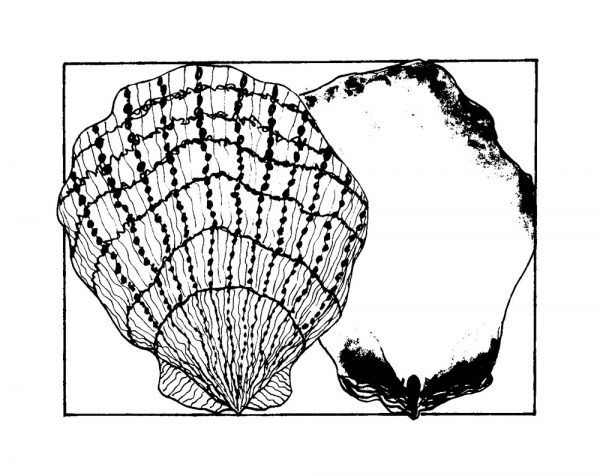Secrets of a Special Scallop

Although one has not been allowed to remove shells from the beach in Laguna for many years, finding a shell gives one the opportunity to learn about a particular creature in our ecosystem. One of the larger and, at least on the outside, duller shells that contains one of the more interesting creatures is the purple-hinged scallop (Crassadoma gigantea formerly named Hinnites giganteus). Purple-hinged scallops are mollusks and classified as bivalves with two hinged fan-shaped shells called valves. Able to grow to a massive nine inches across, the outside of the valves are colored in shades of brown with coarse striations. It is irregular in shape and covered with encrusting marine organisms such as barnacles and sponges, which mask its classic scallop shell shape. The inside of the heavy shells are smooth and white with bright purple around the hinge area. The body of the scallop itself is usually orange in color and made up of soft tissues that contain the heart, digestive system, nervous system and an adductor muscle which is used to open and close the shells. When the shells are open, the orange flesh is visible and around the perimeter of the tissue is a short fringe of tentacles with rows of tiny blue eyes.

Patchily distributed with a range between Alaska to Baja California, purple-hinged scallops live in the low intertidal zone up to a depth of 250 feet. Although the sexes are separate, hermaphroditism occasionally occurs. In addition, scientists are studying if the species are protandrous, which means that the scallops start life as males then change into females as they grow. Reproducing once or twice a year depending on geographic location, they are broadcast spawners, where sperm and microscopic eggs are released into the water column. Once fertilized, the eggs develop into planktonic larvae that drift for over 30 days before coming to rest in the sand. As they start to develop their bright orange shell, the juveniles are both able to swim away from predators by opening and closing their valves, as well as attach themselves temporarily to surfaces with their byssal threads. By the time they reach one to two inches in size, they cement themselves to rocks and other hard surfaces where they will remain for the rest of their lives. The lifespan of the purple-hinged scallop is thought to be between 25 to 50 years.
Purple hinged scallops are suspension feeders, and although they occasionally eat detritus, their primary diet is phytoplankton and algae that they sieve from the water. Predators include sea stars, crabs, octopuses, sea otters and humans. Because of their patchy distribution within their range, they are in danger of overfishing and there has been no commercial catch of this species in California for decades. However, they are still popular with recreational fisherman and divers because of their delicious meat and some of the larger scallops are starting to become scarce. Purple hinged scallops can usually be found out of direct sunlight in rock crevasses, at a depth of five feet or more within high-flow water areas. Look for a band of bright orange along the edge of the shells which is the mantle that may disappear quickly as you approach. Laguna Beach is a marine reserve where any take of sea life is prohibited including the tasty purple-hinged scallop.
Artist Jan Sattler and Mia Davidson are residents of Laguna Beach and year-round ocean swimmers who want to remind you that Laguna Beach is a state marine reserve, where collecting or fishing is forbidden.




